Art Deco Jewelry • Art Deco Rings
The Art Deco movement in jewelry was known for its bold styles, flashy designs, and innovations in manufacturing. The Art Deco Period specifically refers to the era between World War 1 and World War 2 – approximately 1920-1935. The Art Deco era coincided with the “roaring ’20’s” where more middle class people could afford luxuries, like jewelry. Art Deco Rings became popular status symbols, from young flappers looking to show off their modernity, to wealthy society matrons flaunting jewels from famous makers like Tiffany, Cartier, et al.

Art Deco Diamond Engagement Ring with classic geometric filigree design.
Most of us have heard the word “deco” thrown around by countless designers, jewelers, etc.- but more often than not we hear it used incorrectly. We also use the Art Deco design era as one of the most important inspirations for our current custom designs, and as such we are avid students of the Art Deco years. If you, too, are interested in learning about the Art Deco period, or just want to drool over some amazing pieces of jewelry, continue on below.

Early Art Deco Diamond & Platinum Jewelry shows its Edwardian roots with modern design elements.
The Art Deco era was a unique period in the art and design world, resulting in revolutionary ideas in areas of fashion, architecture, home furnishings, and especially jewelry. To understand this period one must understand the decade leading up to the 1920s. Europe had been fully preoccupied by the horrors of World War I so the following peacetime caused a light-hearted spirit to sweep the continent, resulting in a boom in the worlds of art and academia. In the United States the post war era caused a financial boom- the roaring 20s- that lead to increased household incomes and freedoms. This happier attitude and increasing financial means allowed ordinary people to buy nice things, like cars, homes, and jewelry.
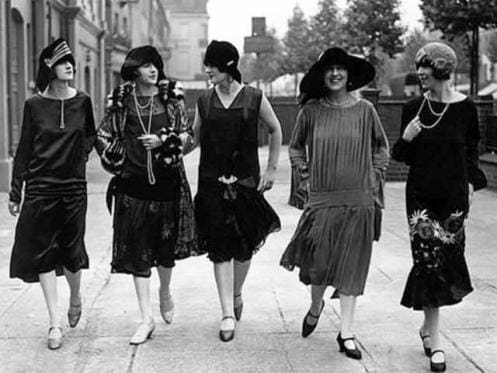
Flapper Women of the 1920s
There were also a couple of unintended consequences of the war that seemed to fuel the Art Deco movement. Women who prior to the war were restrained by social etiquette and corsets did not want to give up the freedom they found through war-time work. Thus what had been necessity on farms and in factories during the war effort became fashionable after the war- shorter dresses and sleeves, short hair, no corsets, fun accessories, etc. (notice the short hemlines, v-necklines, fun hats, and chunky jewelry accessories that the “flappers” in the below image are wearing). At the same time the world was seeing more innovations in science and technology. While the mechanized warfare of WWI was horrific, many scientists and businessmen realized that the same technologies used during the war could be modified and applied to the arts and manufacturing of other products. Americans and Europeans alike took pride in the advances in industry and technology that was fueling growth.
In response to these trends, the French ministry of commerce organized the 1925 Exposition International des Arts Décoratifs et Industriels Modernes. This was a large trade fair intending to draw international notice to the artists and jewelers in Paris who were creating these new and unusual designs. The jewelry exhibit blew away all who came to see it (so much so that the Art Deco moniker came from this show). Some jewelers found inspiration in the discovery of King Tutankhamen’s tomb and used ancient motifs like scarabs and Egyptian gods in modern pieces. Other jewelers seemed to be inspired by the bold designs of the Far East. Tiffany made pieces inspired by the art and nature of Japan, Cartier made pieces inspired by the Moghul rulers of India. Other jewelers came up with totally new designs, like Van Cleef and Arpel’s invention of invisible setting which is so popular today. The one theme that seemed to run throughout all of the jewelers was a love of bold, symmetrical designs that were far less frilly that the Art Nouveau pieces. Gone was the love of nature and delicate femininity seen in Nouveau or Edwardian jewels, and in came a love of bold design. These jewelers wanted their pieces to be worn and enjoyed, making jewelry a statement of personal style.
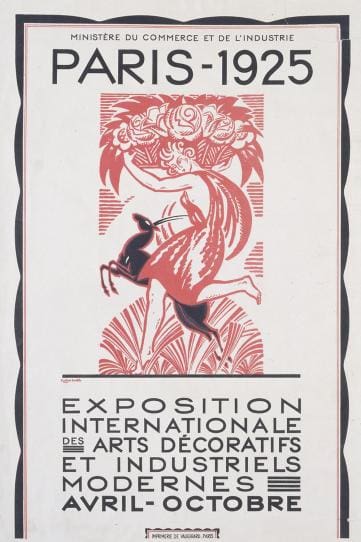
Art Deco Poster
The Art Deco movement in jewelry was known for totally new designs and manufacturing innovations. The pre-war pieces were more ornate, intended to be worn at formal occasions and candlelight dinners whereas the Deco pieces were more symmetrical, with a focus on geometry and order that contrasted with previous eras, and were designed for everyday wear. Many new materials were employed at this time. Platinum and white gold, relative new inventions, became popular. Advances in die-striking allowed jewelers to mass produce ring settings and master the art of filigree. Many lapidaries used light science and new cutting tools to improve Diamond cutting. Modern round brilliant cut diamonds were becoming popular, replacing the Old European Cuts, but there were also some more unusual cuts invented or popularized at this time, such as marquise, emerald cut and Asscher cuts. These unusual shapes played perfectly in geometric designs, and became favorites of the high-end jewelers of the era. Additionally, new sources of colored gemstones were found in South America and the far East, resulting in higher quality colored stones used in pieces. Advances in synthetic gemstones allowed jewelers to invent calibre cutting, which used precision cut matched stones to make intricate designs. The number of design and technique innovations in the Art Deco Era are too numerous to list.
Interestingly, those who could afford jewelry in the early 1900s had few choices: either pay for high end items, or order mass-made jewelry (like from the Sears Catalogue), but increased selection ruled the day in the 20s. Gone were the days of women wearing plain gold wedding bands, and in was an era of ordinary people wearing diamonds and custom made jewelry. Even two rings that looked similar would be different, as hand chasing and engraving of the metal made each piece unique, and items ordered in small town jewelry stores could be modified to match the hottest trends in magazines and on the screen. Jewelry manufacturing companies popped up across the US, like Peacock in Chicago, Traub and Jabel in New Jersey, Belais in New York, etc. which supplied semi-custom mountings to jewelers all over the globe. These jewelers could buy the latest designs from these manufacturers, then customize them for their clients. While the base was mass produced (think die struck ring mounts or orange blossom wedding bands), the end result could be made as unique as the client wanted it.
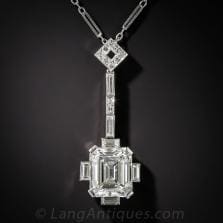 |
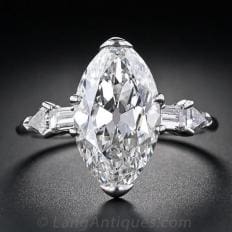 |
 |
The above and below items, 6 pieces of stunning Art Deco jewelry, and perfect examples of Art Deco designs. The pendant at left is set in platinum, with a long drop to take advantage of plunging neck lines, with geometric Emerald Cut and baguette Diamonds. The middle ring shows a Marquise Diamond- a newcomer to the Diamond world- flanked by baguette and Trillion Diamonds, a look popularized by Cartier. The top right ring showcases a fantastic natural intense Yellow Diamond set into a cushion shaped ring, which features intricately milgrained platinum corners, baguette and round Diamond accents, and a perfectly symmetrical look which draws the eye toward the center Diamond. The below left brooch is an example of Van Cleef’s invisible setting from the 1930s, set with rubies in a brooch. The middle is a classic Art Deco three stone ring set with a round Diamond and baguettes, all mounted low for everyday wear. The last item at bottom right is a classic Deco cocktail ring set with Diamonds and calibre cut synethic Sapphires specially cut to accentuate the geometry of the ring. Magnifique!
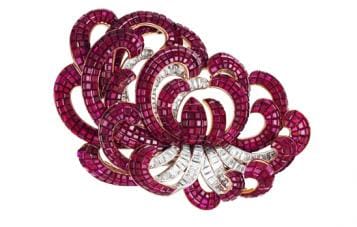 |
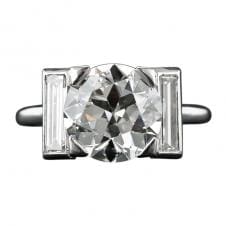 |
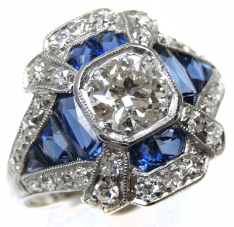 |
The Art Deco period has had a lasting impact on jewelry design. It was during this era that we first saw platinum used in mass, and the first era in which white metal was used more than yellow gold for fine jewelry. Also, prior to this time we had never seen the use of smaller colored gemstones in jewelry design. From the Van Cleef invisible settings, to calibre´ rubies, emerald and sapphires set in intricate motifs: fine gemstones were used to highlight incredible workmanship and design. The below ring is a classic Art Deco wedding set- round Diamond set in square ‘fishtail prongs’, stepped shoulders for a nod to the Egytian, with Diamond accents and fine carving throughout, making it a piece of art.
We hope we have helped you fall in love with Art Deco Jewelry, and if you were considering Art Deco Rings, or an Art Deco Engagement Ring, we hope you consider browsing our collection.

Contact us for more details on Art Deco pieces we may have in stock. We owe a special thanks to the Gemological Institute of America, Romanov Russia, and Antique Jewelry University (a fabulous website courtesy of Lang Antique Jewelry) for the amazing photographs in this piece.
